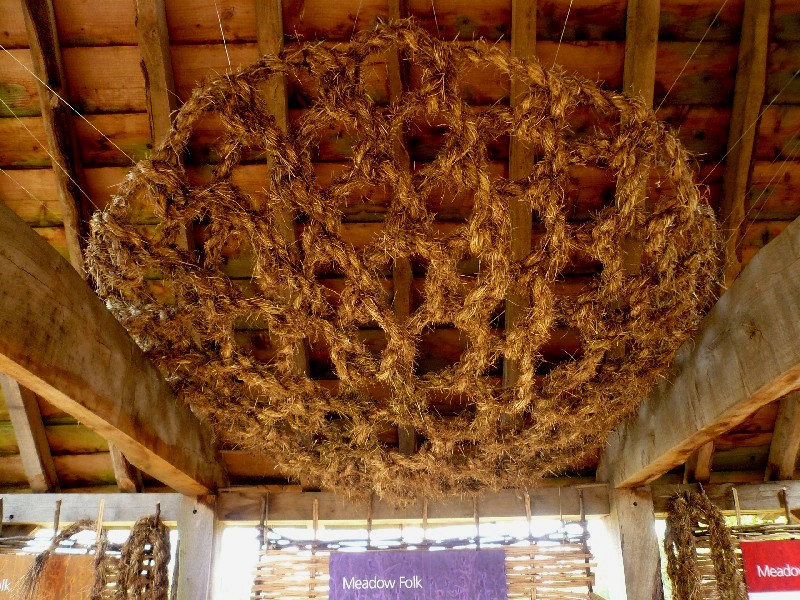I’ve returned to Wakehurst on a sunny autumn day to see if the rumours are true… I’ve heard that birds have nested in the work I made here. My godson showed me a blurry photo on his mobile, so now I’ve got to see this for myself, in person.
There’s a carpet of cyclamen in flower under the huge dark trees as I enter Wakehurst, and all around are glorious autumn colours in the leaves. It rained all morning so there are few visitors, and the gardens are peaceful.
It’s over a year since my ‘Meadow Weave’ residency here, when I made a large piece for the timber-framed buildings (which are next to the Millennium Seed Bank). It was due to be taken down after a few months, but it’s been kept in place and I’m pleased to see that it’s lasted well and is looking in overall good shape.

The piece is made of 70 metres of looped hay rope, using hay grown at Wakehurst. It references agricultural uses of hay/straw rope, and hay-making communities.

Entering the timber-framed buildings, I greet the robin, perched on the edge of the work.
The piece itself is a little stretched and distorted from damp weather coming in through the open-weave wattle walls, and also by the inevitable handling by visitors. Other than that it’s stood up well, and has proved itself more robust than I might have expected.

I notice a nest on the side beam next to the work in the corner under the eaves.
On inspection I see it’s a thrush’s, possibly a song thrush, being a bit too tidy for that of a blackbird. Made this spring, it would have housed several dark-spotted blue eggs.
However, the nest I’ve heard about and come to see is quite different from this one. Large and unkempt, a shallow construction of dark-coloured twigs, it was made by a pigeon or dove.
The amazing thing about this nest is its placement. It’s been built right on top on my hay netting, snug up under the eaves. It rests on the work as on a large hammock.
There are two large-ish white eggs, so white they’re almost tinged blue. I can see the nest has been disturbed, most probably by human hands. There’s a spider’s web on the nest that tells me the parent birds are long gone; the eggs are stone cold.
The nest would have been well protected from predators. But not from humans.

I hear later that pigeons often make more than one nest and don’t incubate them all. I momentarily feel consoled. But when I later examine the eggs closely, it’s clear that they weren’t far off hatching, so the likelihood is that the parents were disturbed. I really hope the thrushes had more success.
At first these nests seem like an avian vote of confidence in the piece I made. I love the reciprocal symmetry it seems to suggest, the safe harbour the work appeared as to the birds. Later, on reflection, I have mixed feelings, more nuanced, with tinges of regret.
I’m reminded of an article I read recently about wildlife thriving at Chernobyl. The site is well-populated with elk, roe deer, red deer, wild boar, foxes, wolves, and others. A rare Przewalski’s horse and European lynx have been seen, which were previously gone from the region but now returned. There are also reports of European brown bear in the exclusion zone. These bears haven’t been seen in the region for more than a century.
But here’s the rub: “It’s very likely that wildlife numbers at Chernobyl are much higher than they were before the accident,” says Jim Smith of the University of Portsmouth in the UK. “This doesn’t mean radiation is good for wildlife, just that the effects of human habitation, including hunting, farming, and forestry, are a lot worse.”
Read the full article about wildlife at Chernobyl here
And you can read other entries about my residency at Wakehurst here